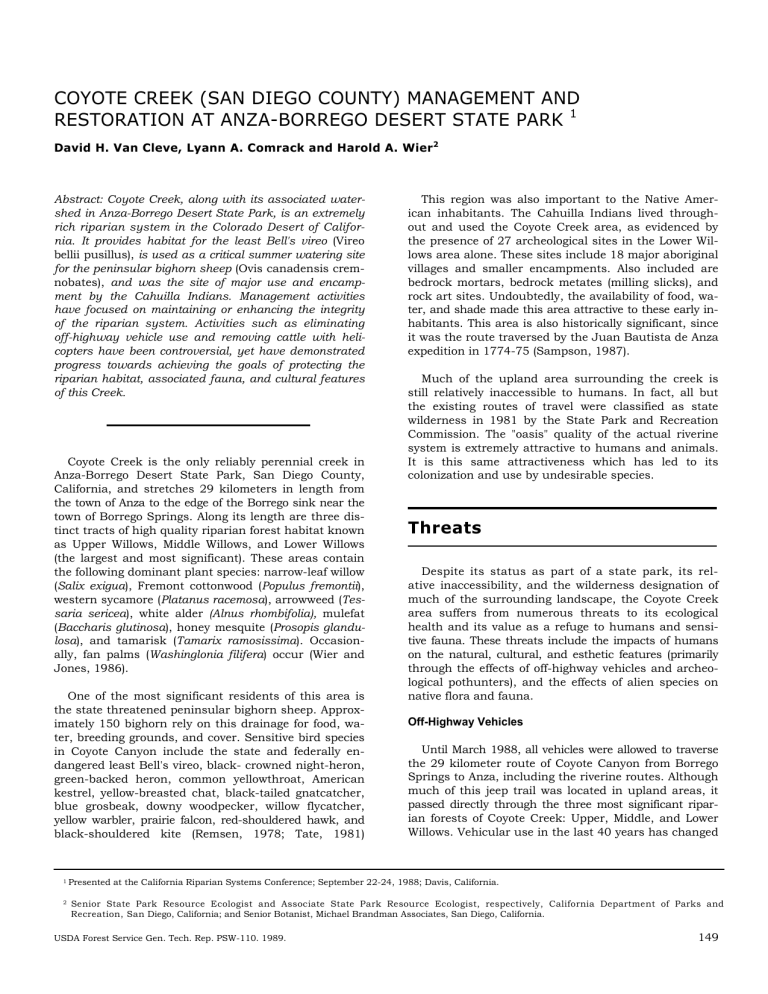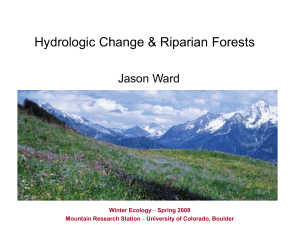COYOTE CREEK (SAN DIEGO COUNTY) MANAGEMENT AND

COYOTE CREEK (SAN DIEGO COUNTY) MANAGEMENT AND
RESTORATION AT ANZA-BORREGO DESERT STATE PARK
1
David H. Van Cleve, Lyann A. Comrack and Harold A. Wier 2
Abstract: Coyote Creek, along with its associated watershed in Anza-Borrego Desert State Park, is an extremely rich riparian system in the Colorado Desert of California. It provides habitat for the least Bell's vireo (Vireo bellii pusillus), is used as a critical summer watering site for the peninsular bighorn sheep (Ovis canadensis cremnobates), and was the site of major use and encampment by the Cahuilla Indians. Management activities have focused on maintaining or enhancing the integrity of the riparian system. Activities such as eliminating off-highway vehicle use and removing cattle with helicopters have been controversial, yet have demonstrated progress towards achieving the goals of protecting the riparian habitat, associated fauna, and cultural features of this Creek.
Coyote Creek is the only reliably perennial creek in
Anza-Borrego Desert State Park, San Diego County,
California, and stretches 29 kilometers in length from the town of Anza to the edge of the Borrego sink near the town of Borrego Springs. Along its length are three distinct tracts of high quality riparian forest habitat known as Upper Willows, Middle Willows, and Lower Willows
(the largest and most significant). These areas contain the following dominant plant species: narrow-leaf willow
( Salix exigua ), Fremont cottonwood ( Populus fremontii ), western sycamore ( Platanus racemosa ), arrowweed ( Tessaria sericea ), white alder (Alnus rhombifolia), mulefat
( Baccharis glutinosa ), honey mesquite ( Prosopis glandulosa ), and tamarisk ( Tamarix ramosissima ).
Occasionally, fan palms ( Washinglonia filifera ) occur (Wier and
Jones, 1986).
One of the most significant residents of this area is the state threatened peninsular bighorn sheep. Approximately 150 bighorn rely on this drainage for food, water, breeding grounds, and cover. Sensitive bird species in Coyote Canyon include the state and federally endangered least Bell's vireo, black- crowned night-heron, green-backed heron, common yellowthroat, American kestrel, yellow-breasted chat, black-tailed gnatcatcher, blue grosbeak, downy woodpecker, willow flycatcher, yellow warbler, prairie falcon, red-shouldered hawk, and black-shouldered kite (Remsen, 1978; Tate, 1981)
This region was also important to the Native American inhabitants. The Cahuilla Indians lived throughout and used the Coyote Creek area, as evidenced by the presence of 27 archeological sites in the Lower Willows area alone. These sites include 18 major aboriginal villages and smaller encampments. Also included are bedrock mortars, bedrock metates (milling slicks), and rock art sites. Undoubtedly, the availability of food, water, and shade made this area attractive to these early inhabitants. This area is also historically significant, since it was the route traversed by the Juan Bautista de Anza expedition in 1774-75 (Sampson, 1987).
Much of the upland area surrounding the creek is still relatively inaccessible to humans. In fact, all but the existing routes of travel were classified as state wilderness in 1981 by the State Park and Recreation
Commission. The "oasis" quality of the actual riverine system is extremely attractive to humans and animals.
It is this same attractiveness which has led to its colonization and use by undesirable species.
Threats
Despite its status as part of a state park, its relative inaccessibility, and the wilderness designation of much of the surrounding landscape, the Coyote Creek area suffers from numerous threats to its ecological health and its value as a refuge to humans and sensitive fauna. These threats include the impacts of humans on the natural, cultural, and esthetic features (primarily through the effects of off-highway vehicles and archeological pothunters), and the effects of alien species on native flora and fauna.
Off-Highway Vehicles
Until March 1988, all vehicles were allowed to traverse the 29 kilometer route of Coyote Canyon from Borrego
Springs to Anza, including the riverine routes. Although much of this jeep trail was located in upland areas, it passed directly through the three most significant riparian forests of Coyote Creek: Upper, Middle, and Lower
Willows. Vehicular use in the last 40 years has changed
1 Presented at the California Riparian Systems Conference; September 22-24, 1988; Davis, California.
2 Senior State Park Resource Ecologist and Associate State Park Resource Ecologist, respectively, California Department of Parks and
Recreation, San Diego, California; and Senior Botanist, Michael Brandman Associates, San Diego, California.
USDA Forest Service Gen. Tech. Rep. PSW-110. 1989. 149
dramatically in this area. Originally used by jeeps and trucks as a route for sightseeing and nature enjoyment,
Coyote Creek had, by the early 1980's, become the playground and speedway for motorcycles and All-Terrain
Cycles (ATC). It was evident that the impacts of approximately 1000 vehicles on the riparian system during busy weekends were becoming intolerable. The Department of Parks and Recreation (Department) reevaluated its management practices towards off-highway vehicles because of the destruction of riparian habitat, suspected direct destruction of the nests of sensitive avifauna, deterioration of water quality, uncovering of archeological sites along with associated vandalism and theft, increased soil and bank erosion, the transformation of the area from a quiet sightseeing area to a noisy playground and other concerns (M. Jorgensen, 1987).
Studies also showed that the peninsular bighorn sheep avoided the riverine area during periods of vehicular activity. During those periods of the year when air temperatures are above 35 degrees C, sheep require frequent access to watering sites. Their avoidance of the creek during peak vehicular activity caused stress in the sheep (P. Jorgensen, 1974). This study led directly to the implementation, in 1975, of an annual seasonal closure (June 15 – September 15) of the entire Coyote
Canyon watershed to all persons and vehicles.
In July 1985, funding was secured to take the first step towards providing Lower Willows with permanent protection. Several alternatives were considered. These included extending the seasonal closure forward to March
15 to provide protection for the least Bell's vireo and other sensitive species during the breeding season, and implementing a permit process to limit the amount of traffic in the area. The alternative selected was a plan which proposed relocating the jeep trail out of the riparian forest into a xeric side canyon. Since this proposal provided resource protection and continued to allow vehicular access to the area, the Department felt that its project was fairly benign. The off-highway vehicle enthusiasts were incensed, however, and fought the proposal at every level possible. The proposal was heard by the State Park and Recreation Commission, which voted unanimously in favor of it and the concomitant proposal to classify the Lower Willows area as state wilderness.
The San Diego Off-Road Coalition filed suit against the Department for not meeting the provisions of the
California Environmental Quality Act (CEQA) for this project. After a lengthy process, the suit was adjudicated in favor of the Department in June, 1987. Construction of the bypass route was finalized in March,
1988, and opened to the public soon thereafter. This route now provides permanent protection to Lower Willows from the direct and indirect impacts of regular vehicular traffic. Horse and foot traffic is still allowed in
Lower Willows except during the annual seasonal closure.
The other major action of the Department designed to lessen the impacts of motorized traffic on riparian resources of the area has been the issuance of a ban on all vehicles, except those which are street-legal, throughout the entire park. This ban, effective September 1,
1987, has effectively reduced the total number and type of vehicles accessing the Coyote Canyon area. Dirt bikes, all-terrain cycles, and many dune buggies may no longer be operated in Anza-Borrego Desert State Park.
Although street-legal jeeps, trucks, and motorcycles still have impacts on the riparian forests of Middle and Upper
Willows, these impacts have been greatly reduced. The types of vehicles and recreationists utilizing the area are now involved in slow-moving sightseeing instead of high-speed equipment testing. The physical and esthetic changes have become quite evident even in the short time since the institution of the ban; the traffic corridors have been filling in with thick stands of willow and tamarisk which provide additional avian habitat, and the scouring effect of rainstorms has eliminated many of the more obvious vehicle tracks. This regrowth was set back temporarily in May 1988 because of a wildfire in
Lower Willows.
This ban was also opposed vigorously by off-highway vehicle enthusiasts and groups in the proposal stage.
Large letter-writing campaigns and strong political pressures were brought to bear upon the Department. It even became a major issue in the confirmation hearings of the new director of the Department. The proposal to ban off-highway vehicles was heard separately before the State Park and Recreation Commission, which again voted unanimously in its favor. At the time of this writing, the ban is in effect, and it is expected to remain so.
Threats to Least Bell's Vireo
Various researchers have described the population status of the least Bell's vireo in California (U.S. Fish and Wildlife Service, 1986). Anza-Borrego Desert State
Park provides extremely high quality desert breeding habitat for this species, with Lower Willows as an important population center.
An intensive survey for least Bell's vireo was conducted in the park during 1986. A total of 32 territorial male vireos was found distributed in seven localities in the northern portion of the park. This figure is somewhat higher than estimates from past surveys, but is probably a reflection of more thorough and intensive field work rather than a population gain. Of this total, 9 were located in Lower Willows, representing 28 percent
150
USDA Forest Service Gen. Tech. Rep. PSW-110. 1989.
of the total territorial males in the local desert population. Nesting success (percent of nests that produced vireo fledglings) was 54 percent, consistent with results found by researchers in coastal localities. Brown-headed cowbirds were prevalent in riparian habitat throughout the park. Cowbird nest parasitism was implicated as a significant factor reducing vireo productivity; at least
80 percent of the nests in Lower Willows had been parasitized (Wier and Jones, 1986). Future expansion of the least Bell's vireo into seemingly suitable habitat in
Middle and Upper Willows will be dependent on the reduction of the cowbird parasitism threat.
The Department began a vigorous cowbird reduction program in 1986 in an attempt to reduce significantly the local cowbird population. Six traps were built and set in
Lower Willows, Riviera Farms (a private horse ranch), and the park's own Horse Camp. A total of 56 cowbirds was trapped, removed, and killed in the park in 1986.
The dead cowbirds were frozen and donated to the San
Diego Natural History Museum for use as study skins.
The trapping results were somewhat disappointing, but can probably be attributed to a late start date that year (May 12th). The cowbird trapping program has continued through 1988 in Lower Willows. 170 cowbirds have been trapped and removed during the first part of this year's breeding season (Griffith and Griffith, 1988).
The Department plans to continue the trapping program for several more years. The program will be improved as knowledge of cowbird dispersal patterns in Coyote
Canyon increases.
Tamarisk Eradication
Tamarisk is a well documented problem species in the
Southwest (Kerpez and Smith, 1987). As a phreatophyte, it evapotranspires tremendous amounts of water into the atmosphere. The result of this evapotranspiration is a reduction in the amount of water available for wildlife and for native riparian and waterhole plant species. Tamarisk tends to form dense, monotypic stands, outcompeting native vegetation. It is also less preferred as wildlife habitat than native riparian species.
Tamarisk is pervasive in the Coyote Canyon drainage with several severe infestation areas.
During May 1988, approximately 150 acres of riparian vegetation were burned in Lower Willows due to an escaped campfire. Two weeks after the burn, tamarisk had vigorously resprouted from underground rootstalks.
Seedling establishment was also noted. The Department's response was to send workers into Lower Willows to cut and chemically treat the tamarisk. A park-wide tamarisk eradication program has been conducted since
1983, but had focused on remote springs and drainages where infestation has not been as severe. Past removal work included cutting the specimen with chainsaw or
USDA Forest Service Gen. Tech. Rep. PSW-110. 1989. loppers, and immediately applying the herbicidal agent
Garlon-4 to the cut stump. Results have been encouraging. Following two successive seasons of removal work, a mortality rate of 95 percent on treated tamarisk has been achieved. Garlon-4, produced by Dow Chemical, is brushed or sprayed on the tamarisk stump immediately after the stem has been severed. Tamarisk resprouting has been minimal with the use of this chemical. Also,
Garlon-4 is not a restricted pesticide, which makes it easier to obtain and use than other, more powerful, herbicides (Comrack, 1987). Techniques developed by park staff will be used on the Lower Willows tamarisk infestation problem in order to reduce the negative impacts of this weed on the riparian system. The fire consumed portions of riparian habitat used for nesting purposes by the least Bell's vireo. What direct effect the fire had on this population of vireos is unknown. Five territorial males have been noted in Lower Willows after the fire.
We suspect that vireos may colonize nearby but previously unoccupied habitat at Middle or Upper Willows.
Further surveys will be required to confirm this possible relocation.
Another unfortunate side effect of the fire was its removal of the duff and litter layer in Lower Willows.
Since this area had been used extensively by the Cahuilla
Indians, the surface evidence of their occupation became very evident after the fire. Park rangers made an arrest for vandalism of a Cahuilla grave site, which included the possession of the remains of human cremation.
Feral Cattle
Livestock can cause many types of resource damage in riparian systems. They may compete with native wildlife species for food and water, destroy the riparian corridor through overgrazing, pollute surface water flows, compact soil, and increase erosion of streambanks. Additionally, domestic livestock carry contagious diseases which are deadly to the peninsular bighorn sheep (Jessup, no date). The presence of an increasingly large population of feral cattle in the backcountry of Anza-Borrego Desert State Park has long threatened the resource integrity of Coyote Canyon. Although grazing leases were canceled in 1971, remnant herds multiplied prolifically in the absence of any natural predators.
Also, numbers of cattle increased from the illegal entry of branded cattle onto park property from neighboring ranches. Past efforts to rope, herd, and/or trap the cattle resulted in failure.
An attempt was made in 1985 to introduce a bill in the State Legislature which would allow the Department to shoot feral cattle within the boundaries of the state park. This proposal met intense opposition from the
California Department of Food and Agriculture and both the State and County Cattlemen's Associations.
151
In the only avenue left unexplored, the Department initiated an aerial animal capture program, utilizing the professional services of Skydance Operations, Inc., of
Minden, Nevada. Skydance provided a Hughes 500D helicopter especially equipped for aerial animal capture, pilot, net-gun operator, and other support staff in order to capture and transport the cattle successfully.
Removal efforts were concentrated in Coyote Canyon due to the significance of its resource values and because past cattle damage to the drainage had been most severe.
The field operation was broken into four phases as described below:
Phase 1: A continuous supply of alfalfa was placed in key locations in Coyote Canyon a few weeks before the airlift operation began. Establishment of the feeding stations served to lure the animals into predetermined target range.
Phase 2: Early morning reconnaissance flights served to locate large concentrations of cattle. During the actual animal capture, the pilot used the helicopter to herd the targeted bovine into the open. The animal was then captured with a net fired from a gun designed to be used from a helicopter hovering about 4 meters from the target. After firing, the 5 by 5 meter net settled onto and entangled the targeted animal. Captured cattle were hobbled with heavy leather straps, hoisted by hook to the helicopter, and flown out to holding pens erected in the park's Horse Camp.
Phase 3: Ground crews subdued and untethered the cattle after they were unhooked from the helicopter.
Veterinarians working independently from the Bighorn
Research Institute in Palm Desert, California, collected blood samples and nasal swabs from each animal for diseases analysis. Cattle were then released to await transport.
Phase 4: Through an arrangement with the Bureau of
Livestock Identification, truckloads of cattle were taken from the Horse Camp to the town of Brawley. Animals were held for 14 days to determine ownership status. All unclaimed cattle were then sold at auction.
The feral cattle removal operation began March 31,
1987 and continued through December 18 of that year.
A total of 111 cattle were captured from Coyote Canyon and nearby Buck Ridge (M. Jorgensen, 1988). Although any animal capture operation poses some risk to the animals involved, all personnel and cattle escaped injury during transport. Disease analysis of blood and nasal discharge samples taken from the cattle was conducted independently by the Bighorn Research Institute. Preliminary results indicate that cattle have been exposed to many of the viruses which have decimated bighorn populations, including Para-Influenza III, Blue
Tongue, Bovine Viral Diarrhea, Bovine Respiratory Synicital Disease, and Epizootic Hemorrhagic Disease (De-
Forge, 1987). It is hoped that this cattle removal pro-
152 gram will help ensure the long-term health of the Coyote
Canyon bighorn population.
In an effort to prevent further ingress of feral cattle into the park now that most existing animals had been removed, a fencing project was conducted in 1987. Approximately 13 miles of barbed-wire fencing were constructed at a cost of $194,000 on the western boundary of the park. Sites were selected which did not conflict with bighorn habitat and which were suspected to be major cattle ingress routes (M. Jorgensen, 1988).
Conclusions
The Department of Parks and Recreation has taken several important steps to identify and correct threats to the natural, cultural, and esthetic resources of Coyote
Creek in Anza-Borrego Desert State Park. It is continuing to assess the populations of least Bell's vireo, peninsular bighorn sheep, and other sensitive species through contracts and volunteer programs. The Department is also continuing to monitor the success of the cowbird removal program through a contract and the success of the tamarisk removal and the Off-Highway Vehicle ban through studies conducted by park staff. It is vital that these monitoring efforts continue on a regular basis; they are expected to continue for several years. Even though these steps have been controversial at a variety of levels, they have been in concert with the legal mandates of the department and in conjunction with Departmental goals in the field of resource management. It is essential that established processes and laws be adhered to at each and every step. Too often, projects are stopped or delayed, not on their respective merits, but rather because the established process was not followed. In order to carry out resource management projects successfully, identification of and adherence to the process is an essential step of implementation.
Acknowledgements
We thank Anza-Borrego Desert State Park Naturalist
Mark C. Jorgensen for contribution of field work, leadership, and coordination on all of these projects.
References
Comrack, Lyann A. 1987. Project Status Report on the
1986/87 Statewide Resource Management Program
Project: Tamarisk Control, Anza-Borrego Desert State
Park. Located at the Southern Region Office, Department of Parks and Recreation, San Diego, California.
USDA Forest Service Gen. Tech. Rep. PSW-110. 1989.
DeForge, James. Director, Bighorn Research Institute.
[Telephone conversation with Lyann A. Comrack]. 1987.
Griffith, Jane, and John Griffith, Wildlife Biologists under contract to the Department of Parks and Recreation.
[Telephone conversation with Lyann A. Comrack]. August, 1988.
Jessup, David. No date. Diseases of Domestic Livestock which Threaten Bighorn Sheep Populations. California
Department of Fish and Game, Wildlife Investigations
Laboratory, Rancho Cordova, California.
Jorgensen, Mark C. 1987. Off-Highway Vehicle Use in Anza-
Borrego Desert State Park. California Department of
Parks and Recreation Publication. Located at the Southern Region Office, Department of Parks and Recreation,
San Diego, California.
Jorgensen, Mark C., State Park Naturalist, Anza-Borrego
Desert State Park. [Telephone conversation with David
H. Van Cleve]. June, 1988.
Jorgensen, Paul D. 1974. A Survey of Vehicle Use at a Desert Bighorn Watering Area. Transactions of the
Desert Bighorn Council.
Kerpez, T., and N. Smith. 1987. Saltcedar control for wildlife habitat improvement in the Southwestern United
States. U.S. Department of the Interior. U.S. Fish and
Wildlife Service. Resource Publication #169.
Remsen, J. V. 1978. Bird Species of Special Concern in
California. California Department of Fish and Game,
Wildlife Management Branch. Administrative Report
#78-1.
Sampson, Michael P. 1987. An Archaeological Study of the
Proposed Bypass Route, Lower Willows, Coyote Canyon,
Anza-Borrego Desert State Park. Located at the Southern
Region Office, Department of Parks and Recreation, San
Diego, California.
Tate, James, Jr. 1981. The Blue List for 1981. American
Birds 35:1 (3-10).
U.S. Fish and Wildlife Service. 1986. Least Bell's Vireo
Management Plan. Portland, Oregon.
Wier, Harold A., and Barry Jones. 1986. A Survey of the
Birds of Riparian Habitats, Anza-Borrego Desert State
Park, San Diego County, California, with Emphasis on the
Least Bell's Vireo and Brown-Headed Cowbird. Westec,
Services, Inc., Environmental Services Division. San
Diego, California.
USDA Forest Service Gen. Tech. Rep. PSW-110. 1989.
153
SESSION D: RIPARIAN SYSTEMS AND FOREST
MANAGEMENT
Forest streams create unique conditions along their margins, and even though a distinctive vegetation may not be present, managers have recognized the need to minimize disturbances in streamside corridors. Early management emphasis was on controlling sediment delivery and maintaining conditions that would support fisheries. The wider role that streamside vegetation plays in the ecosystem of forested basins and their streams is only now being fully appreciated. Many advances have occurred since the 1981 California Riparian Systems Conference.
Two papers link forest management practices in and near the riparian zone with water temperatures and physical structure of the channel as it is affected by coarse woody debris.
Another paper deals with the status of an unusual forest understory element, the Pacific yew.
The final papers deal with management of riparian systems in watersheds where decomposed granitic soils and landslides exert significant influences.
The papers in this session emphasize the high priority that riparian systems are starting to receive in forest management.
Bruce McGurk
Pacific Southwest Forest and Range Experiment Station, Forest Service
Berkeley, California
USDA Forest Service Gen. Tech. Rep. PSW-110. 1989.
155







